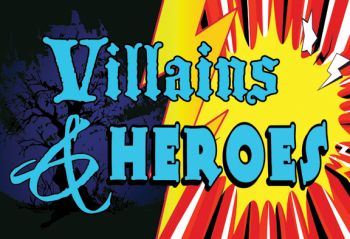Villains and Heroes: 5•19•19
Symphony no. 1, “The Lord of the Rings” | I. Gandalf, the Wizard by Johan de Meij
Dutch composer Johan de Meij (b. 1953) wrote Symphony no. 1, “The Lord of the Rings,” for concert band in 1988, and the following year, it won the Sudler Composition Award. Based on themes from the fantasy epic novel The Lord of the Rings, by J. R. R. Tolkien, the symphony consists of five movements, each illustrating one of the novel’s key characters or episodes. “Gandalf, the Wizard” is the first movement and characterizes Gandalf the Grey, a wise and immortal wizard. Tolkien referred to Gandalf as an “angel incarnate,” and literary scholars have compared the wizard to the Norse god Odin. Tolkien had intended The Lord of the Rings to be a sequel to his earlier children’s book, The Hobbit, but then developed it into a much longer, more complex work. He spent 12 years writing the work and another 5 years getting it published. The epic was finally released in three volumes from July 1954 through October 1955. Addressing themes of fellowship, leadership, home, and conquest, The Lord of the Rings is one of the best-selling novels ever written, with more than 150 million copies sold.
Der Traum des Oenghus, Opus 37, Part I, by Rolf Rudin
German composer Rolf Rudin (b. 1961) has written for most musical genres but is particularly well known for his compositions for concert band. Most of his works are commissioned, and some have been selected as compulsory pieces for German and international competitions. Rudin was commissioned to write the musical poem “Der Traum des Oenghus” (“The Dream of Oenghus”), the first part of a two-part composition, in 1993–1994 by the Confederation of German Band and Folk Music Associations. The piece is based on an Irish legend about Prince Oenghus, who falls in love with the subject of a nightly dream: a girl who plays the flute. Of course, the girl disappears each time he awakens and so is unattainable. The sounds and patterns in the opening and closing of the piece capture the mysterious atmosphere described in the legend, and the chant that develops with growing intensity but then dissolves represents the intangible nature of dreams.
Lincoln Portrait, by Aaron Copland (trans. Walter Beeler)
American composer Aaron Copland (1900–1990) wrote “Lincoln Portrait” in 1942 as a commission from Andre Kostelanetz, conductor of the New York Philharmonic Orchestra. Kostelanetz selected three composers (Copland along with Jerome Kern and Virgil Thomson) to create orchestral portraits of famous Americans in an effort to bolster Americans’ spirits during the early days of World War II. Copland chose President Abraham Lincoln as his subject and decided to include narration with the piece because of Lincoln’s powerful oratory about war and freedom. The narration begins seven minutes into the piece and the text is taken from Lincoln’s writings and speeches, including his presidential campaign debates with Stephen Douglas, several of his annual State of the Union addresses, and “The Gettysburg Address.” In composing the music for the piece, Copland said that he had “hoped to suggest something of the mysterious sense of fatality that surrounds Lincoln’s personality.”
Tom Hegg, Narrator
Intermission
Concerto for Alto Saxophone and Wind Ensemble, I. Song: Fire in the Earth, by David Maslanka
American composer David Maslanka (b. 1943) has published nearly 100 pieces, including nine symphonies, nine concertos, and a full mass, but his compositions for winds and percussion are especially well known. Maslanka was commissioned to write Concerto for Alto Saxophone and Wind Ensemble by a consortium led by the University of Texas at Austin and the University of Arizona. The piece was premiered in March 2000 by the University of Arizona Symphonic Wind Ensemble (Gregg Hanson, conductor) with Joseph Lulloff as the solo saxophonist. Maslanka has described his inspiration for the first movement, “Song: Fire in the Earth,” as follows: “Walking through a Montana field on a brilliant late fall day, three images came in rapid succession: a distant row of red plant stems caught by the morning sun, snow on the surrounding high mountains, green grass at my feet…. This is a quiet, emotional music—sometimes not so quiet—contained by a very simple song form.”
Adam Pazandak, Alto Saxophone Soloist | 2019 Earl C. Benson Concerto Competition Winner
Night on Bald Mountain Modest Mussorgsky (trans. Mark H. Hindsley)
Russian composer Modest Mussorgsky (1839–1881) based “Night on Bald Mountain” on themes from the pagan festivities of the Slavic holiday related to the summer solstice. The composer was inspired by the short story “St. John’s Eve,” by Nikolay Gogol, in which St. John witnesses a witches’ Sabbath on Bald Mountain, near Kiev in the old Russian Empire. The witches engage in a night of wild, frenetic dancing, and when the church bell rings at sun-up, they vanish. Mussorgsky wrote “Night on Bald Mountain” in 1867, but it was rejected for performance. His attempts to revise the piece proved futile, and it remained unfinished upon his death in 1881. Composer and friend Nikolay Rimsky-Korsakov spent two years piecing together Mussorgsky’s notes and score, intent on completing the piece in a manner true to the composer’s style. He conducted the premiere of “Night on Bald Mountain” in 1886, five years after Mussorgsky’s death.
Princess Leia’s Theme, by John Williams (arr. Donald Hunsberger)
John Williams (b. 1932) has 50 “Best Music” Oscar nominations and 5 wins, as well as 23 Grammys and a range of other awards. His score for Star Wars was selected by the American Film Institute as the greatest American film score, and the soundtrack has been preserved by the Library of Congress in the National Recording Registry for its cultural, historical, and aesthetic significance. “Princess Leia’s Theme” is an example of Williams’s use of the leitmotif technique to connect the audience with the story and characters. In the 1977 film, Leia’s theme is heard at several points: first when she is captured by Darth Vader, again when R2-D2 plays her holographic message to Obi-Wan Kenobi, and finally in the credits at the end of the film. The theme also appears in various forms throughout the other films in the Star Wars franchise.
Star Wars (Main Theme), by John Williams (arr. Donald Hunsberger)
John Williams began composing film scores in 1958, but it wasn’t until the release of Star Wars in 1977 that he was fully established as a composer and recognized by both Hollywood insiders and members of the general public. As the “big screen” met the Space Age, Williams delighted audiences with a full-scale, symphonic score that drew on themes of famous nineteenth-century composers, such as Richard Wagner and Gustav Holst. Movie-goers recognized the themes of heroes, lovers, and enemies, which would spill over into Williams’s later films, and other composers would try to emulate his style. At a time when many directors and producers were steering away from full-scale original scores, Williams’s approach revived a style that had been essential to adventure films from the late 1930s through the mid-1950s.
Program notes by Sue Freese
Upcoming Performances
Join our mailing list
Subscribe to our email newsletter to learn about upcoming concerts.


